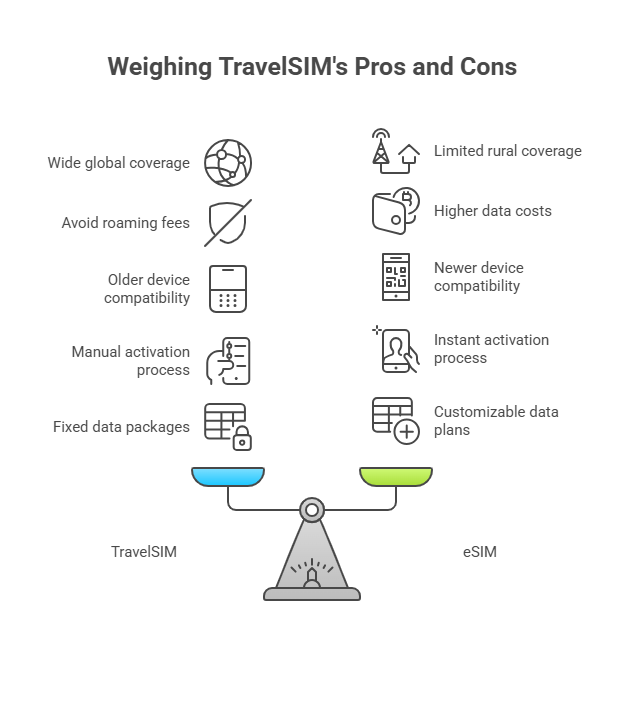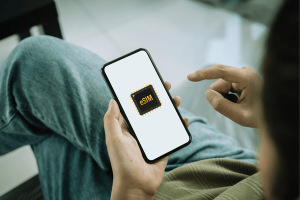But it’s not perfect for every traveler. This guide highlights the key pros and cons of TravelSIM to help you decide whether it’s the right choice for your next trip.
What is TravelSIM and Why Should You Consider It?
TravelSIM is an international SIM card service designed to keep you connected in over 200 countries. Unlike traditional roaming services tied to your carrier, TravelSIM lets you bypass costly fees and set up your phone with international data, calls, and texts at fixed rates.
With eSIM technology gaining traction, TravelSIM is often compared to modern eSIM services. While eSIMs offer advanced flexibility and instant activation, TravelSIM is still a notable option for travelers who prefer physical SIM cards, ensuring compatibility with older phones or networks that may not support eSIMs.

The Pros of Using TravelSIM
1. Wide Coverage Across the Globe
TravelSIM works in more than 200 countries, which means you’re likely to stay connected whether you’re backpacking through Southeast Asia, attending a conference in Europe, or taking a safari in Africa. This extensive reach eliminates the need to purchase multiple local SIM cards for different regions.
For comparison, some eSIM providers also aim for global coverage, but they can still face limitations in certain remote or rural areas.
2. Avoid Unexpected Roaming Fees
One of TravelSIM’s strongest selling points is its ability to shield you from surprise roaming charges. Traditional carriers often charge exorbitant rates for international roaming. TravelSIM offers a clear pricing structure, so you’ll know what to expect upfront.
3. Compatibility with Older Devices
While eSIM technology is innovative and flexible, it’s only supported by newer smartphones. TravelSIM, being a physical SIM card, works with both older and newer models, making it a universal solution.
4. No Need to Switch Plans Back Home
With TravelSIM, you keep your current domestic SIM tucked away safely until you return. This eliminates the hassle of switching carrier plans just for international travel.
5. Easy Call and Text Options
Though data is often the primary focus for most international SIM users, TravelSIM also simplifies call and text functionality. You can make and receive calls with an international number, which is invaluable for emergencies or professional communications.
The Cons of Using TravelSIM
1. Higher Costs for Heavy Data Users
While TravelSIM offers affordable rates for occasional use, travelers who consume large amounts of data may find it expensive compared to eSIM services. Many eSIM providers now offer competitive unlimited data plans, which outshine TravelSIM for heavy users who stream or upload frequently.
2. Manual Activation Process
Unlike eSIMs, which can be set up instantly by scanning a QR code, TravelSIMs often require manual setup. This might involve inserting the SIM card, adjusting your phone’s settings, and verifying network connectivity. For tech-savvy users, this process may feel outdated.
3. Limited Plan Flexibility
TravelSIM offers fixed data packages rather than customizable plans. This is a drawback for travelers whose data needs fluctuate depending on the destination or duration of their trip.
4. Outdated Compared to eSIMs
With eSIM technology enabling features like dual-SIM functionality and remote activation, traditional physical SIM cards like TravelSIM are beginning to show their age. If your smartphone supports eSIMs, exploring those options might make more sense.

TravelSIM Pricing Breakdown
TravelSIM pricing depends on your destination and selected package. Packages often include pre-loaded credit for data, calls, and texts. While the rates are competitive compared to traditional roaming, make sure to calculate your expected usage to avoid running out of credit mid-trip.
For travelers on extended trips, top-up options are available. However, as a general trend, data rates are more expensive with TravelSIM compared to some leading eSIM providers, particularly for regions with high data usage demands.
How to Set Up TravelSIM
Getting started with TravelSIM is straightforward but less seamless than eSIMs:
- Order Your SIM – Purchase a TravelSIM online and have it delivered to your address before your travel date.
- Choose a Package – Select a data bundle, confirm your destination, and activate the plan.
- Insert the SIM – Once you arrive at your destination, replace your phone’s domestic SIM with TravelSIM.
- Adjust Settings – Update your phone’s APN settings to ensure you connect to TravelSIM’s supported partner networks.
If you prefer instant activation and no shipping delays, consider exploring Terminal eSIM’s affordable eSIM solutions.
Real-Life Use Cases for TravelSIM
Case 1: Business Travel to Multiple Countries
Sarah, a management consultant, often travels across Asia, Europe, and the Americas for client engagements. Using a TravelSIM, she avoids buying multiple local SIM cards while maintaining reliable call and text functionality across regions. For added data flexibility, she complements her TravelSIM with an eSIM for digital-heavy tasks.
Case 2: Vacation in Remote Locations
TravelSIM proves helpful for travelers exploring destinations with spotty reception. Paul and his family used TravelSIM during their road trip through remote parts of the Andes, where certain eSIM providers lacked network coverage.
TravelSIM vs. eSIMs – Which Should You Choose?
Both solutions have their merits. If your device supports eSIM technology and you need fast setup with flexible data options, eSIMs are likely the superior choice. Terminal eSIM offers seamless instant activation and affordable international plans for travelers of all types.
On the other hand, if you’re using an older device or frequently make international calls, TravelSIM could be a better fit.
Frequently Asked Questions
1. What is TravelSIM?
TravelSIM is an international SIM card that provides data, calls, and texts in over 200 countries.
2. Can I use TravelSIM with my smartphone?
Yes, TravelSIM is compatible with most unlocked phones, including older models that don’t support eSIM technology.
3. Is TravelSIM better than eSIMs?
It depends on your needs. TravelSIM works well for older devices, but eSIMs are faster to activate and offer better data flexibility.
4. How much does TravelSIM cost?
Pricing varies by destination and package. Be sure to check rates for your planned travel regions before purchasing.
5. Can I top up my TravelSIM?
Yes, you can add credit online via TravelSIM’s portal or app.
6. Do unused TravelSIM credits expire?
Some credits may have expiration dates. Check the terms of your package for specifics.



